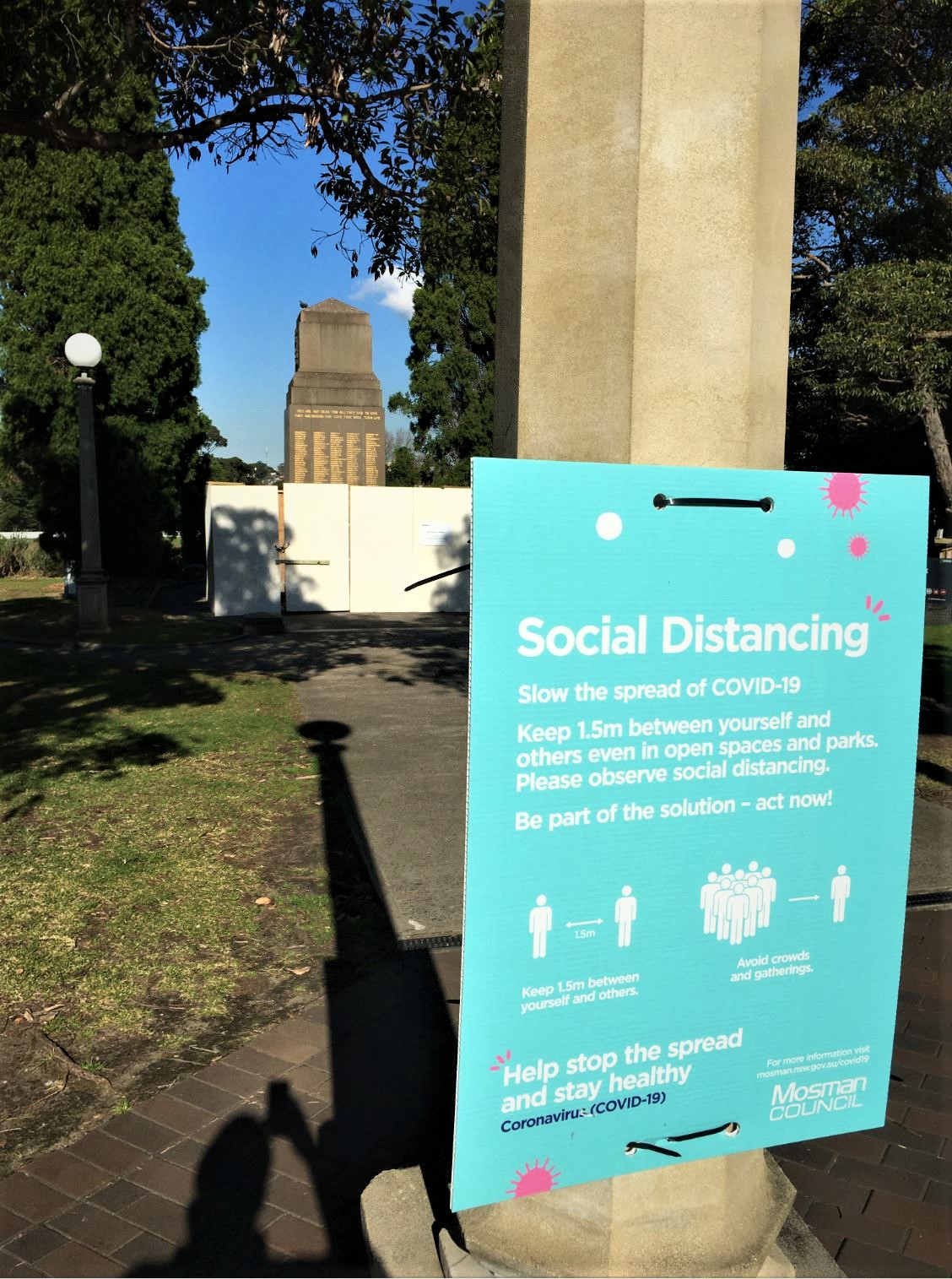
 Mosman Memorial in iso’ , July ’20 Photo by author
Mosman Memorial in iso’ , July ’20 Photo by author
The Mosman War Memorial seemed to be in lock-down like the rest of us during the Covid crisis. The ‘Flu Pandemic of 1919 was probably slowing down 101 years ago. We can empathize at their plight, having experienced something like it.
As you approach the Memorial now, lists of names carved gold into the smooth dark granite glitter in the sun. The names of men associated with the area who survived or died in the Great War. If you read your way around the headings in capitals on the top, they become a rhyming elegy :
THEY HARKENED FREEDOM’S RALLYING CRY,
THEY PUT ALL SELFISH PURPOSE BY,
HUMBLE WERE THEY, WE SET THEM HIGH,
THEY ARE NOT DEAD FOR ALL THEY HAVE TO GIVE,
THEY SACRIFICED FOR LOVE THAT LETS THEM LIVE

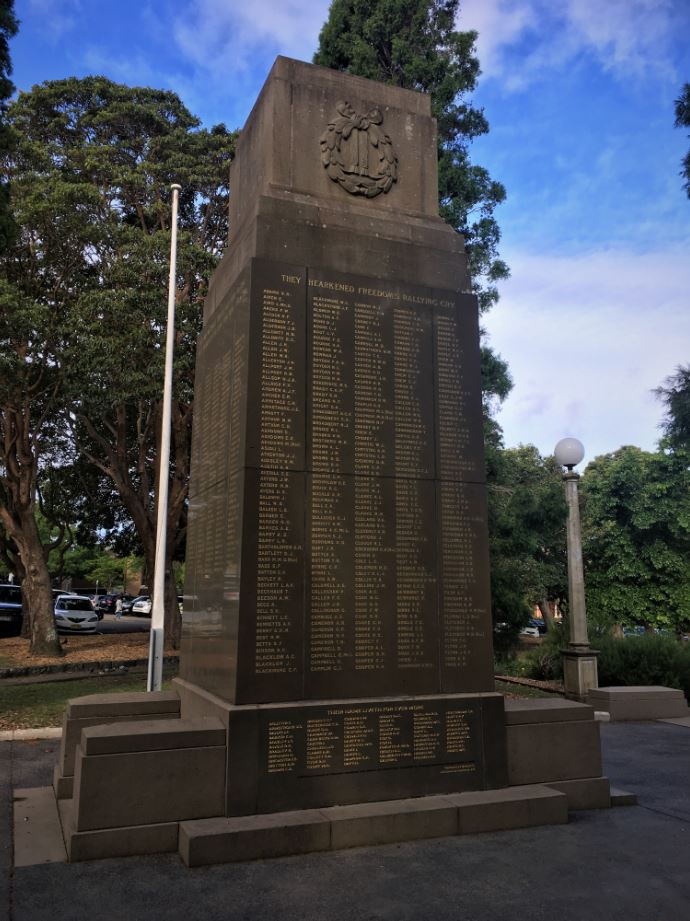
 Inscibed below the names on the North face reads: ‘Greater love hath no man than this, that a man lay down his life for his friends’ – John XV.13’. And the foundation stone below this says ‘In honoured memory of the men of Mosman who fought in the Great War 1914-19. -1922.’ Photos by the author Nov ’20
Inscibed below the names on the North face reads: ‘Greater love hath no man than this, that a man lay down his life for his friends’ – John XV.13’. And the foundation stone below this says ‘In honoured memory of the men of Mosman who fought in the Great War 1914-19. -1922.’ Photos by the author Nov ’20
So who were THEY? What was their fate?
THEY were people from all walks of life. Clerks, teachers, graziers, mechanics, engineers, lawyers, builders. Many fought in the trenches as Diggers or led as Officers. Others flew in battles in the skies above them. Some did both or served on the seas.
Col. William Bridges commanded the 1st AIF at the Gallipoli landings. He was picked off by a sniper weeks later. Lt. Redford fell with the 9th Light Horse Regiment at the ‘Nek’. Allan Allsop, a stretcher bearer witnessed the horrors of the trenches and kept a diary. Corporal Dargan and Brett Allport survived the war but succumbed to their wounds afterwards. Allport’s brother Jack joined the Flying Corps. The Richardson brothers were promoted to Captain before being killed, L.L Richardson died just before being awarded the Military Cross, so it was received by another brother, W.L.P Richardson. In the Wilson family two of three brothers never came home. They were identified with DNA evidence in 2010 near Fromelles. Many died of influenza in 1919, including Oliver Hogue
 Map showing location of Memorial and Richard Bradley’s address, 43 Belmont Rd (now part of the Mosman Public School)
Map showing location of Memorial and Richard Bradley’s address, 43 Belmont Rd (now part of the Mosman Public School)
So we can partiarly answer who they were, and what they did. Quite a few stories remain to be told, many never will be. Two minutes walk from the Memorial was one of the known addresses of Richard Bradley, a 23 y.o. newly-married music teacher killed at Pozieres on the 15/8/1916 with the 19th Battalion. His name also appears on the Australian National Memorial, Villers-Bretonneux with over ten thousand other Australians with no known grave. Many like Bradley were probably obliterated by shells, buried alive or disappeared into the muddy battlefields, with no resting place over which the family could mourn.
Though it is mostly grim reading, there were stories of survival. Such as the two mates who helped each other out after the war. ‘Bill’ Taylor, Charles Ulm, Charles Kingsford Smith and Keith Anderson all beat the odds and later became famous aviators. Local resident Norman Ellison wrote about them.
The psychological effect on veterans returning from the war, some permanently injured, is an area worth studying. The impact on families and society was also substantial, considering the Flu Pandemic of 1919 had to run it’s course before economic activity resumed.
 The Mulligan family show Mosman was not immune to the pneumonic influenza pandemic that swept the world in 1918, taking with it more casualties than World War. Source: Barry O’Keefe Library’s image archive: Trace
The Mulligan family show Mosman was not immune to the pneumonic influenza pandemic that swept the world in 1918, taking with it more casualties than World War. Source: Barry O’Keefe Library’s image archive: Trace
George Franki includes as an eloquent postscript to his book Their Name Liveth for Evermore: Mosman’s Dead in the Great War 1914-1918 Peter Kocan’s poem:1
The photograph
Sometimes in the homes of the elderly,
Among the shabby, cherished possessions
You will find a framed photograph
Of a young man in quaint uniform.Slouch-hatted, posing with a full gaze.
‘My brother Jim. He went to the war …’
And something in the aged voice conveys
The unspoken ‘and didn’t come home’ …The minds wherein he is enshrined
As son, brother, neighbour, friend, grow fewer.
Those brief, sliding minutes on the wharf
Have become sixty years.Now in a musty room somewhere,
An old person makes a cup of tea
And a not-yet anonymous soldier
Stares out of the photograph.
 Three Wilson Brothers. Their mother Isabella died of a broken heart after her two other sons were killed. The youngest son found out about this on return to Australia after being wounded in the same battle.
Three Wilson Brothers. Their mother Isabella died of a broken heart after her two other sons were killed. The youngest son found out about this on return to Australia after being wounded in the same battle.
Those brief, sliding minutes have become a century. The ‘elderly’ with the memories have passed on. Their photographs and shabby, cherished possessions have been inherited, auctioned off, pawned, thrown out, or donated to libraries and museums. Sites such as these bring the events they lived through to light,
Lest We Forget
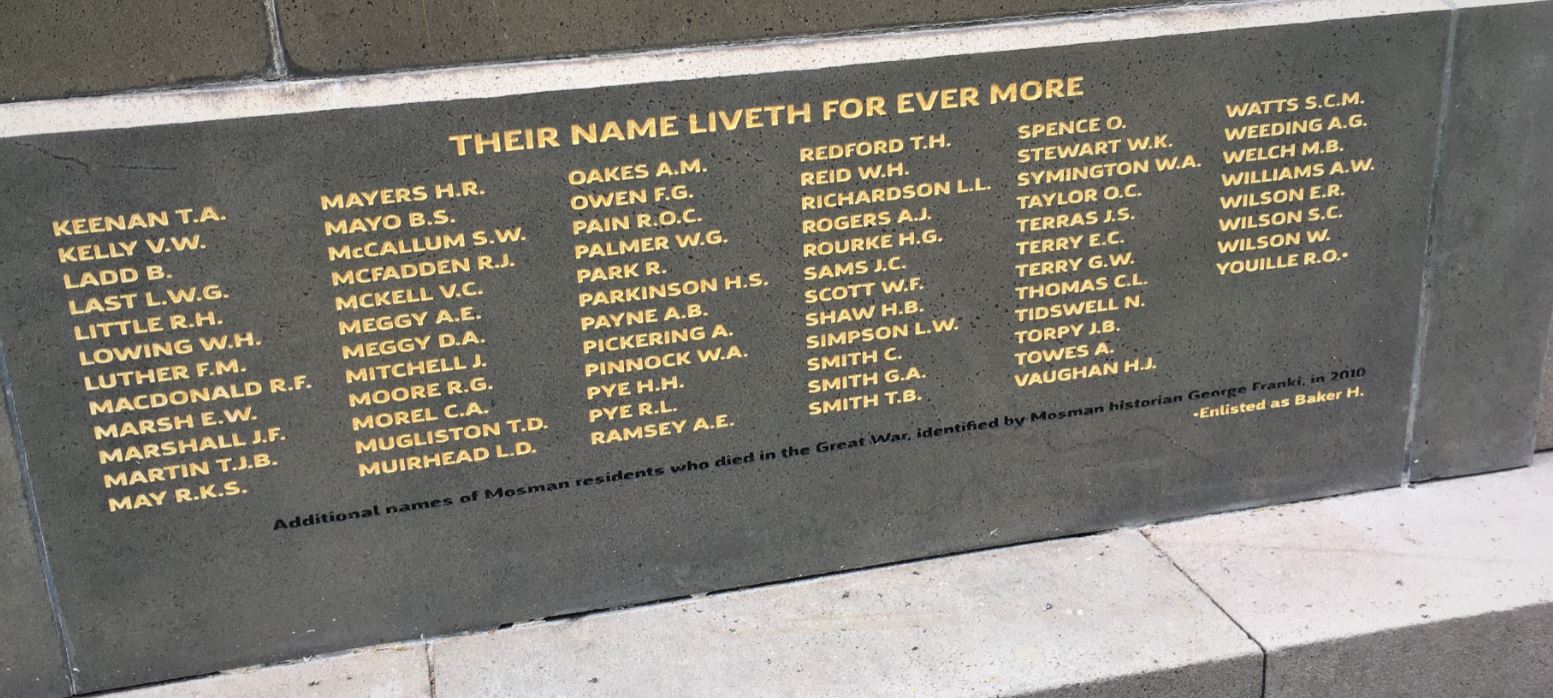 Photo by the author Nov ’20
Photo by the author Nov ’20
Mosman names not on the memorial are still being found. If you know someone that could be added, or wish to add to the Doing Our Bit site, contributions are always appreciated.
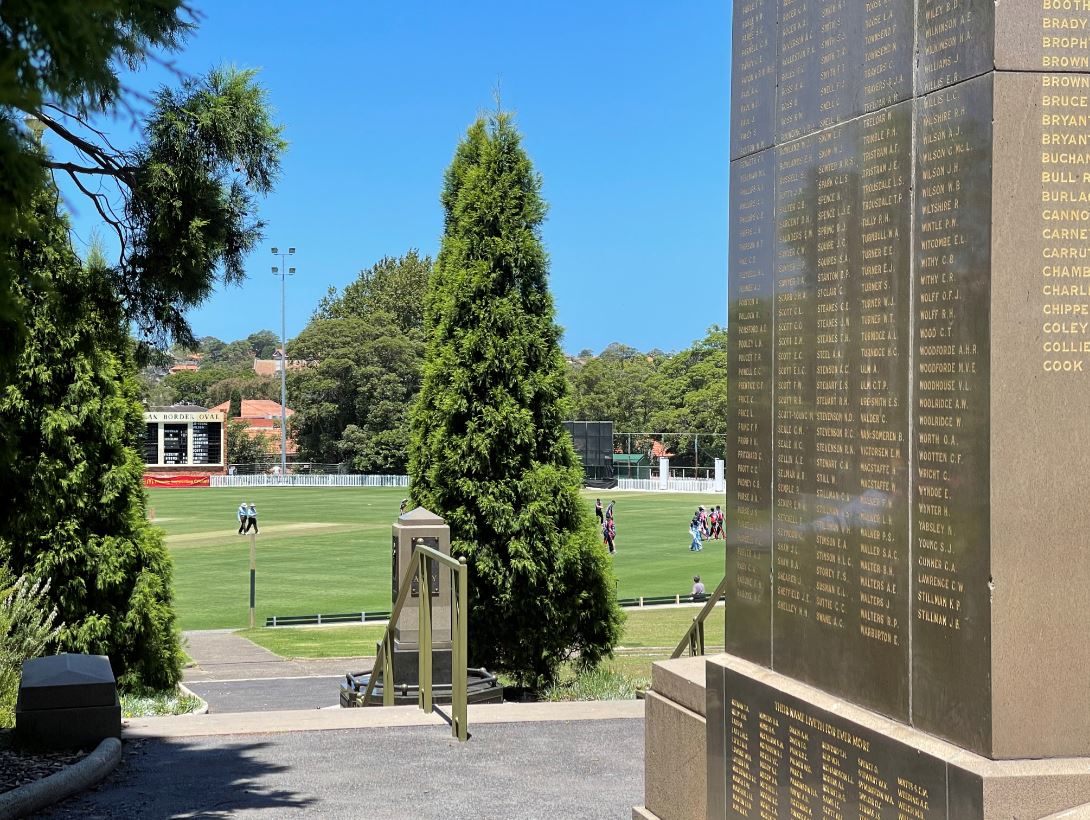
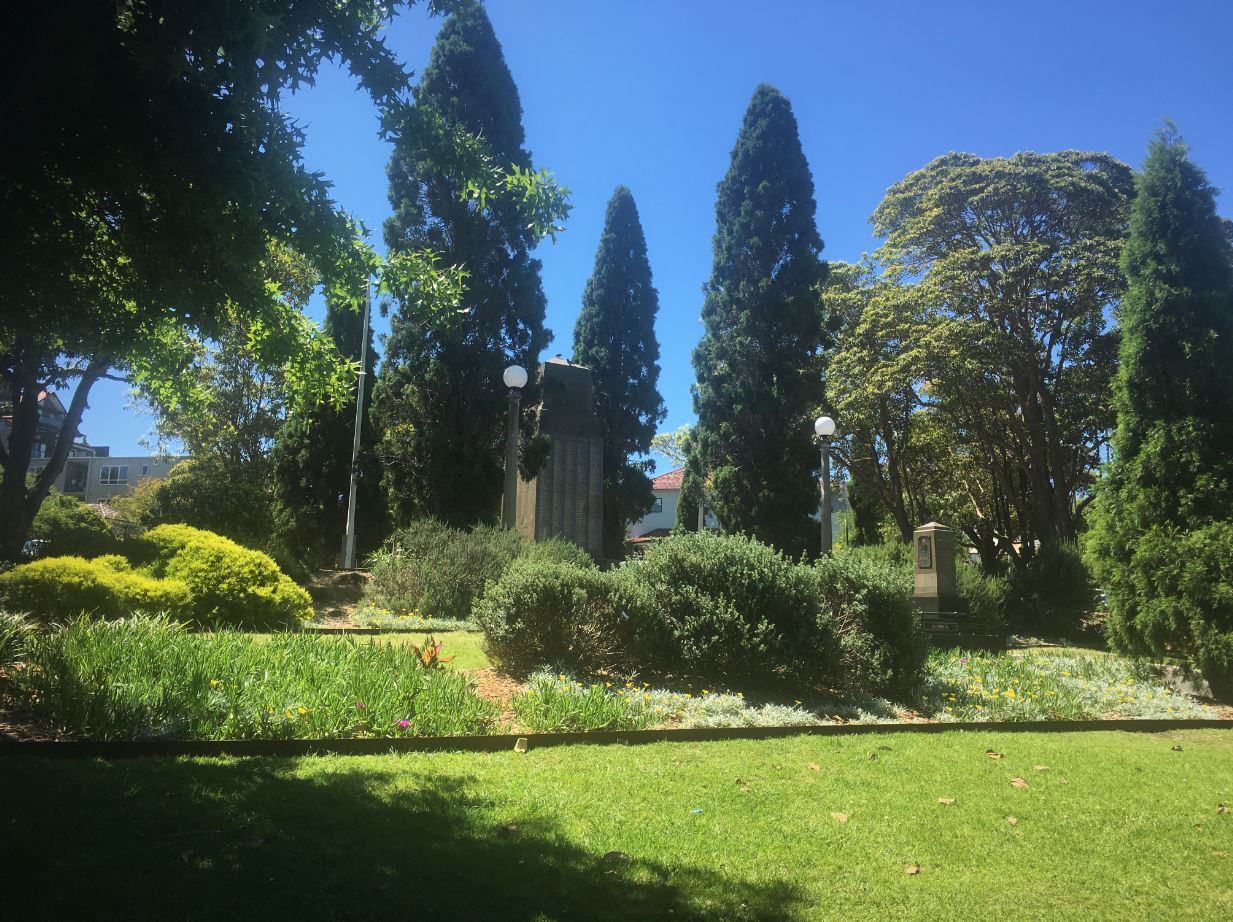 Out of isolation and looking cleaner than ever, despite still being a popular spot for local birds. Great place to have lunch, contemplate the blue-green world or watch a bit of of local cricket or soccer. Photos by author on different days in Oct/Nov ’20 and Jan 21
Out of isolation and looking cleaner than ever, despite still being a popular spot for local birds. Great place to have lunch, contemplate the blue-green world or watch a bit of of local cricket or soccer. Photos by author on different days in Oct/Nov ’20 and Jan 21
1 From one of Bernard de Broglio’s earlier posts